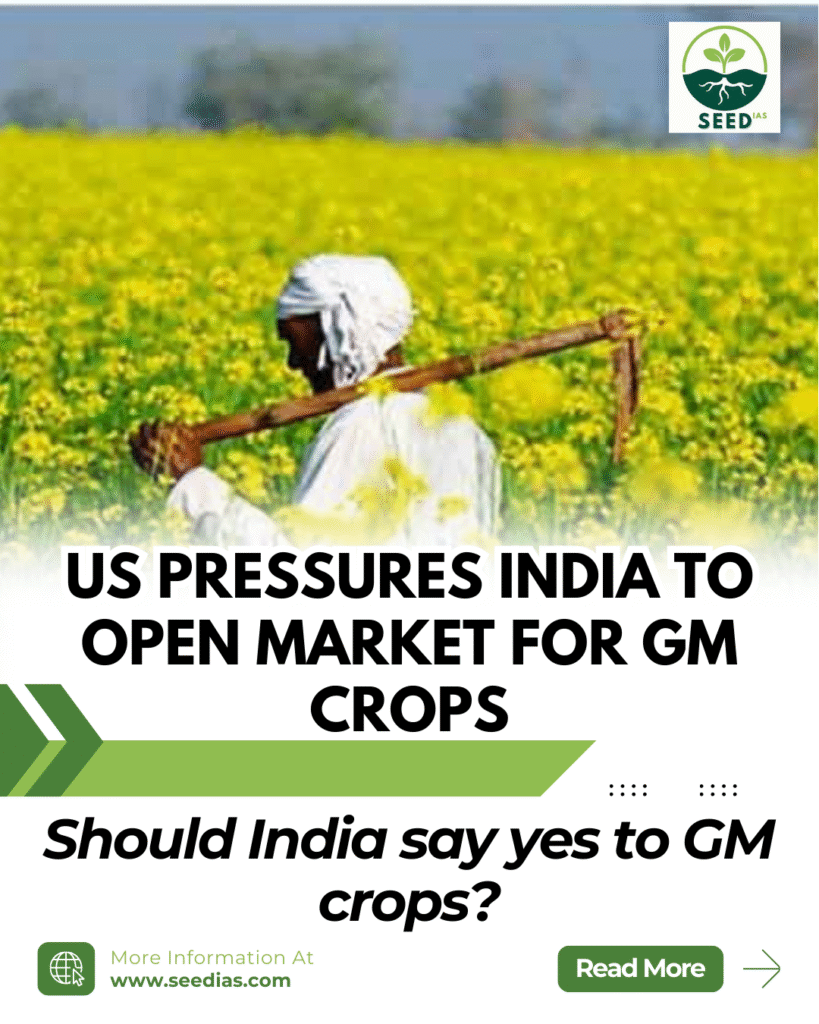Why in NEWS
During ongoing trade talks, the US has urged India to allow the import of genetically modified (GM) crops. India has strongly opposed this, citing threats to farmer livelihoods, food safety, and labeling agriculture and dairy as “sacrosanct red lines.”
Key Concepts & Definitions
| Term | Definition |
|---|---|
| GM Crops | Plants whose DNA is altered using genetic engineering to express desirable traits |
| Bt Cotton | GM cotton that produces its own pesticide (Bacillus thuringiensis toxin) |
| GEAC | Genetic Engineering Appraisal Committee – apex body for GM crop approval in India |
| Biofortification | Nutritional enhancement of crops through genetic modification |
| HT-Bt Cotton | GM cotton variant with herbicide tolerance |
What are GM Crops and Their Global Use?
| Aspect | Details |
|---|---|
| Introduction | GM crops use gene-editing to introduce traits like pest resistance or drought tolerance |
| Global Adoption | Over 17 million farmers in 29 countries cultivate GM crops (190 million hectares as of 2019) |
| India’s Regulatory Framework | Governed by 1989 Rules under Environment Protection Act, 1986 for biosafety |
Current Status of GM Crops in India
| Crop | Status |
|---|---|
| Bt Cotton | Approved in 2002; covers 90% of cotton area; yield decline in recent years |
| Bt Brinjal | Approved in 2009 but under moratorium due to public concerns |
| HT-Bt Cotton | Not approved but illegally cultivated in several states |
| GM Mustard (DMH-11) | Cleared for environment in 2022; awaiting commercial release |
| Other Crops | Chickpea, pigeonpea, sugarcane – under trials and research |
Benefits of GM Crops
| Benefit | Explanation |
|---|---|
| Pest Resistance | Reduces need for pesticides; higher yield and lower costs |
| Climate Resilience | Drought-, heat-, and salinity-tolerant crops aid climate adaptation |
| Nutrition Enhancement | Eg: Golden Rice for Vitamin A, iron-rich rice, zinc wheat |
| Reduced Post-Harvest Losses | Crops like Flavr Savr tomato extend shelf life |
| Medical & Environmental Uses | Biopharming (vaccine crops) and phytoremediation of pollutants |
Challenges in GM Crop Adoption
| Challenge | Description |
|---|---|
| Environmental & Health Risks | Biodiversity loss, gene flow, allergies, superweeds |
| Regulatory Delays | Slow approvals, lack of clarity, moratoriums |
| Socio-Economic Issues | Seed dependency, high input costs, IPR issues (e.g., Monsanto disputes) |
| Illegal Cultivation | Unapproved HT-Bt cotton on ~25% of cotton land |
| Resistance & Stagnation | Bollworm resurgence, declining yields, loss of global competitiveness |
Steps for Responsible GM Crop Adoption
| Strategy | Measures |
|---|---|
| Science-Based Regulation | Independent, transparent, time-bound approval with long-term impact studies |
| Strengthen R&D | Revise price control orders, promote PPPs, boost funding for nutrition-focused GM crops |
| Farmer-Centric Governance | Quality seeds, training, seed sovereignty, labeling, isolation zones |
| International Engagement | Harmonize biosafety norms, focus on biofortified crops through pilot health programs |
In a Nutshell
Mnemonic: GROW SAFE
- Gene-based nutrition
- Resilient to climate
- Open and transparent regulation
- World-class innovation
- Seed sovereignty
- Awareness and labeling
- Farmer-first approach
- Environmental safeguards
Prelims Practice Questions
- Which of the following GM crops is officially approved for commercial cultivation in India?
A. GM Brinjal
B. GM Mustard
C. Bt Cotton
D. GM Chickpea - Which of the following correctly matches the GM crop and its benefit?
A. Flavr Savr Tomato – Drought Tolerance
B. Golden Rice – Vitamin A Fortification
C. Bt Cotton – Heat Resistance
D. C4 Rice – Extended Shelf Life - What is the role of the GEAC in India?
A. Monitor food inflation
B. Approve environmental projects
C. Regulate biotechnology education
D. Approve genetically engineered crops
Mains Practice Questions
- Discuss the prospects and challenges of adopting genetically modified crops in India. In your view, should India open its agriculture market to GM imports? 15 marks (UPSC GS3)
- Highlight the role of genetically modified crops in achieving food and nutrition security in India. Should they be part of India’s climate resilience strategy? 10 marks
Prelims Answer Key with Explanation
| Q. No | Answer | Explanation |
|---|---|---|
| 1 | C | Bt Cotton is the only GM crop approved for commercial use in India |
| 2 | B | Golden Rice is fortified with beta-carotene (Vitamin A) |
| 3 | D | GEAC is the apex body for approving GMOs in India under the Environment Act |
















